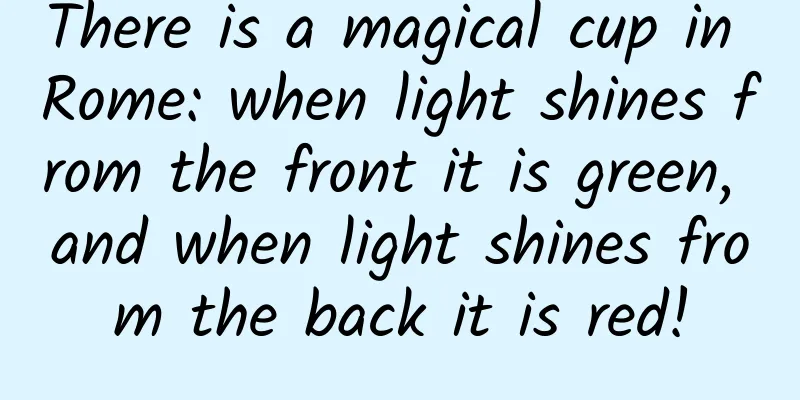There is a magical cup in Rome: when light shines from the front it is green, and when light shines from the back it is red!

|
The author or source of this article or its original publication: Bokeyuan official website: www.bokeyuan.net And mobile software: Bo Ke Yuan Scientists have developed a way to extract richer colors from the available spectrum by exploiting disordered patterns inspired by nature, which are usually seen as black. Their findings are published in the journal Nature Communications. The colors we see in nature often come from nanoscale patterns that reflect light in a specific way. For example, a butterfly's wings may appear blue because the tiny grooves on the wing surface only reflect blue light. However, when a surface appears black or white, it is usually because the structure at the nanoscale is completely disordered, causing all light to be either absorbed or reflected. A team of researchers, led by the University of Birmingham, has now found a way to control the way light travels through these disordered surfaces to produce vibrant colours. The team, which includes colleagues from Ludwig Maximilian University Munich in Germany and Nanjing University in China, compares the approach to a technique that artists have been exploiting for centuries. One of the most famous examples is the fourth-century Roman Lycurgus cup, which is made of glass and appears green when light hits it from the front. But when light shines from behind, it appears red. Now the research team has demonstrated a way to finely control this effect to produce very accurate color reproduction. The different colors in the image are represented on the lithographic plate using different thicknesses of a transparent material, such as glass. The bottom line: The researchers deposited a disordered layer, in this case, consisting of random clusters of gold nanoparticles. Finally, underneath this layer, the team placed a mirror to create a transparent cavity that is able to trap particles of light, or photons, inside. The photons behave like waves inside the cavity, resonating at different frequencies under the lithographic surface and releasing different colors depending on each wave length. By using this technique, the team was able to reproduce a Chinese watercolor painting with exquisite color accuracy. "The different ways nature produces colors are really fascinating. If we can harness them effectively, we could open up a treasure trove of richer, more vivid colors than we've seen so far," said Dr. Silvio. "In physics, we're used to thinking that randomness in nanofabrication is bad. But the researchers showed that in some specific applications, randomness can lead to structures that are superior to ordered structures. In addition, the intensity of light generated in the random structures is really strong, which could be used in other areas of physics, such as new sensing technologies." Illustration (same below): A disordered system transitioning from broadband absorption to band-limited reflection/transmission based on coupled mode theory. Disordered biological structures are ubiquitous in nature, often producing white or black due to their broadband optical response and robustness to perturbations. Through judicious design, disordered nanostructures have been realized in artificial systems with unique properties for light localization, photon transport, and energy harvesting. On the other hand, the tunability of disordered systems with broadband responses has hardly been explored. The study achieved controllable manipulation of disordered plasmonic systems, achieving a transition from broadband absorption to tunable reflection through deterministic control of coupling to an external cavity. Starting from a generalized model, it is recognized that disordered systems composed of plasmonic nanoclusters either work as broadband absorbers or have reconfigurable reflection bands in the visible light range. Studying disordered plasmonic systems is not only of great significance for further understanding of disordered physics, but also provides a new platform for various practical applications, such as structural color patterning. Bo Ke Yuan | Research/From: University of Birmingham Reference journal: Nature Communications Bo Ke Yuan | Science, technology, research, science Follow [Bokeyuan] to see more beautiful cosmic science |
<<: Coral fleece and milk fleece, I finally know how to choose!
>>: How many black holes are there in the universe? The latest number: 400 billion billion!
Recommend
A 62-year-old famous singer accidentally fell during a concert. It turns out that many people suffer from the same disease as him!
The day before yesterday (August 14) #Jacky Cheun...
What are the medicinal values of Asarum?
Asarum is a very common Chinese medicine. The who...
The efficacy and function of willow branches
Willow can be said to be a very common tree in ou...
The efficacy and function of Guangdong native Achyranthes bidentata
Only when we understand the main ingredients of a...
Help! Why do dogs always like to eat poop? The reason is not simple...
This article was reviewed by Lin Zhideng, PhD in ...
The efficacy and function of banana butterfly
Traditional Chinese medicine is very helpful in t...
Will Shanghai impose a large-scale lockdown? Officials refute the rumor: This is not true!
At 17:00 on July 10, Shanghai held a press confer...
A man was scared when 2 liters of oil were drawn from his blood during a physical examination
Recently, Mr. Wang from Hankou had a very profoun...
Why did the old man, who was in good health, die soon after falling down?
In the past two days, many places have welcomed s...
What is the function of mimosa?
Mimosa is also affectionately called the ugly gra...
The effect of Lemahui
Lemahui is a relatively common folk herbal medici...
An ancestral precept has governed the country for 600 years. This "pearl" in the vast forest of northern Fujian is creating an ecological miracle.
Wanmulin Nature Reserve in Jianou City, Fujian Pr...
The efficacy and function of flat cattail fan
The essence of traditional Chinese medicine is to...
TCM treatment of obsessive thinking
Obsessive thinking is a relatively common conditi...



![[Creation and Cultivation Program] The Chinese sturgeon appeared in the market. Is it illegal?](/upload/images/67f0e6cbe5610.webp)





